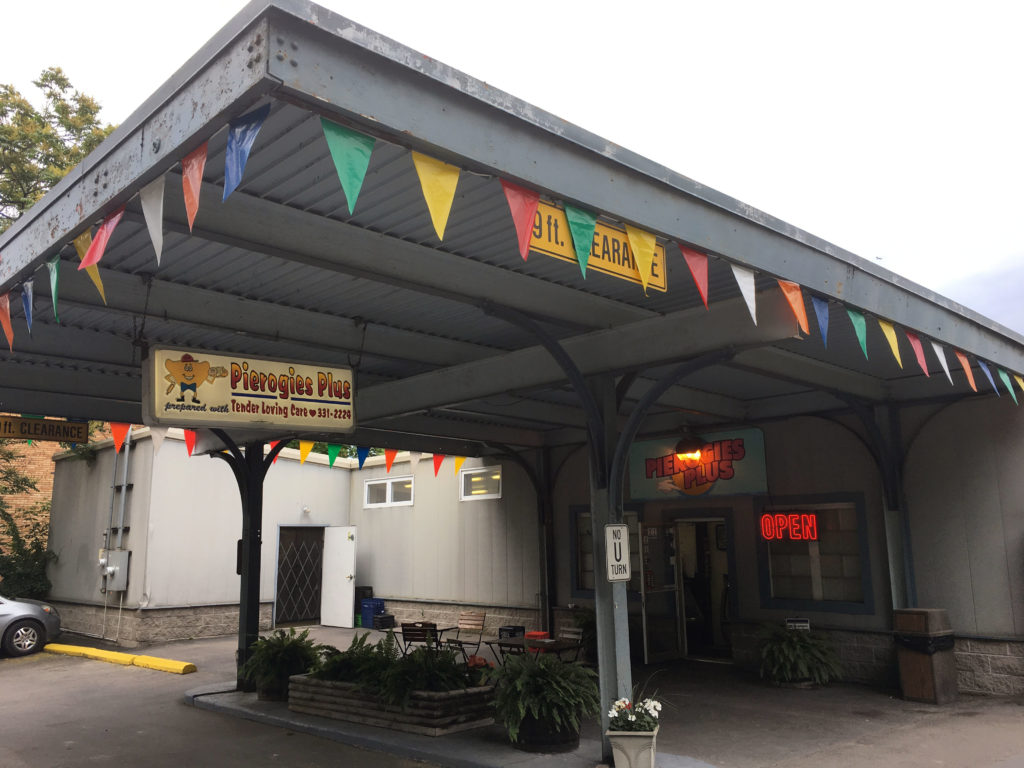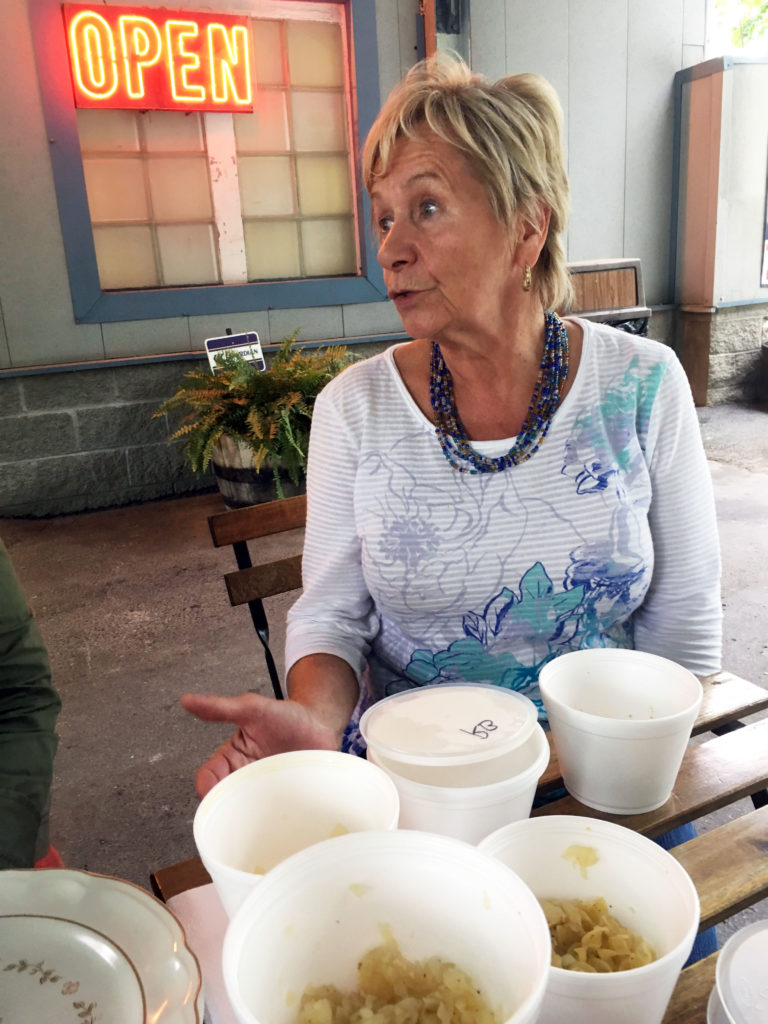We’ve sampled many a dumpling on this show. Bolivian salteñas, mantis from Uzbekistan, Tibetan momos (which, by the way, is the most fun dumpling to say aloud). Somehow, we haven’t talked about the dumpling of Rico’s youth: the Polish pierogi. A staple food of his hometown of Pittsburgh, Pennsylvania.
So last time he visited, he went pierogi eating with Beth Kracklauer, editor of the Wall Street Journal’s James-Beard-Award-winning “Off Duty” Food section, and a Pittsburgh native. Beth took Rico to Pierogies Plus — a former gas station that’s been a Polish food mecca for almost three decades. Before talking with the chef, Rico asked Beth to go back to basics and break down just what exactly is in this delicious dough-wrapped treat.

What is a pierogi?
Beth Kracklauer: They’re any number of different kinds of fillings, in a wheat noodle wrapper. They’re little half-moon-shaped things that can fit in the palm of your hand. They’re typically cooked up with fried onions and a lot of butter.
Rico Gagliano: A lot of butter.
Beth Kracklauer: Very delicious. Classic fillings include plain, sort of mashed potato, potato and cheese, potato and sauerkraut, mushrooms.
Rico Gagliano: Potato figures heavily.
Beth Kracklauer: Yeah, a lot of potato.
How did it become an essential part of Pittsburgh cuisine?
Beth Kracklauer: It’s huge! I grew up in Pittsburgh. I know that you did, too. And if you remember during the 1980s when we were growing up, if you went out to dinner — with a few notable exceptions — your options were Italian, Italian, or if you ate in a bar, which to my mind is still the best way to eat in Pittsburgh, it was pierogies.
During the 100 or so years that the steel mills were really puffing away at full capacity, there was massive immigration from Eastern and Central Europe, and Eastern European and Central European cuisine came to really define eating in Pittsburgh, in homes and in restaurants.
Rico Gagliano: And it still is, to a large extent. The Pittsburgh Pirates have a pierogi race as part of the 7th inning stretch, I believe.
Beth Kracklauer: Yes. Also in the Pittsburgh version of Monopoly, one of the game pieces is a pierogi, of course. It is a real emblem of the city and one I’m quite happy to have as an emblem of the city because they’re delicious!
What puts Pierogies Plus above other pierogi places in Pittsburgh?
Beth Kracklauer: Because it’s the best. Because I love it so much. It’s arguably the most classic. Helen Mannarino, who’s the owner, emigrated here from Poland when she was 18, I think. But also because it’s a real remarkable success story. The neighborhood where we are, McKees Rocks, is an old mill neighborhood, and you hear a lot in the national news about Pittsburgh’s renaissance and how the universities and the tech sector have rushed in to fill the vacuum left by the exit of heavy industry. But this isn’t one of the neighborhoods that’s totally come along for that.
And we’re sitting here in the middle of what is really a food desert. Pittsburgh, among mid-sized cities in the US, it has one of the highest percentages of people living in food insecurity in the country. So the fact that this business has thrived here is a testament to Helen as a businesswoman and as a cook, and what she’s providing here is a real community service. She’s providing food in a place where there aren’t a lot of options.

Rico Gagliano: I do want to take exception to something you said a minute ago. You said this place has kind of the most classic Polish cuisine. I will have to say, I’ve looked at the menu here, it’s a lot of pierogies, very heavy, buttery food. Polish isn’t always like that though, necessarily.
Beth Kracklauer: No, absolutely not. There are plenty of carb-heavy, comforting, wonderful dishes, but there’s also a lot of vegetables. Foraging is a big part of Eastern European Slavic food traditions. Fermenting of vegetables. There’s plenty of light and vitamin-filled food [laughs] on offer in the Polish pantry as well.
Rico Gagliano: And possibly even gluten-free, in some cases.
Beth Kracklauer: Possibly some places. Not here, I don’t think, and that’s OK [laughs].
Rico Gagliano: Let’s eat some of this stuff.
Beth Kracklauer: Let’s do it.
Chatting up Pierogies Plus mastermind Helen Mannarino

Rico Gagliano: We have out here some containers of a bunch of different pierogies, all brought out by the chef.
Helen Mannarino: My name is Helen Mannarino. I am originally from Poland, but living in this country for bigger part of my life.
Rico Gagliano: Let’s talk about some of the stuff that you brought out here. Some of these pierogi fillings I’ve never encountered in bars in my life. What would you recommend that I start with?
Helen Mannarino: OK, you can start with spinach ricotta.
Rico Gagliano: Spinach and ricotta, that’s almost an Italian stuffing, I would think.
Helen Mannarino: Yes. We never made spinach ricotta at home, but when I opened a business, an Italian lady and she said, “Can you make spinach ricotta?” I said, “Well, I never made it.” But I made it, she liked them, and we liked them also. We put them on the menu. Twenty-seven years and they are still here.
Rico Gagliano: I never thought about it, but it makes it kind of like a miniature calzone in a way.
Helen Mannarino: Yes, that’s right.
Rico Gagliano: All right, I want to try one of these because in a way this captures Pittsburgh in one bite because it’s both a Polish and the Italian tradition.
Helen Mannarino: That’s right, that’s right.
Rico Gagliano: So here we go [tastes food]. Oh, my God! That was delicious.
Beth Kracklauer: See how tender the exterior is? It just melts in your mouth.
Rico Gagliano: I understand that people will send their fillings to you to wrap in your dough. What’s your secret to making the dough that light?
Helen Mannarino: That’s a secret.
Rico Gagliano: Come on. We’re both Pittsburghers here, you can just tell me [laughs].


